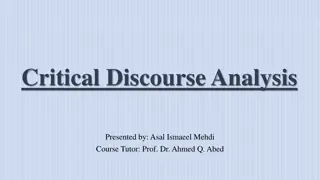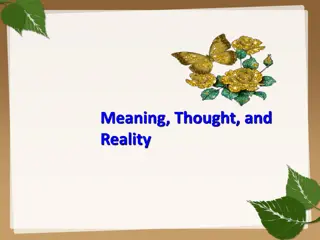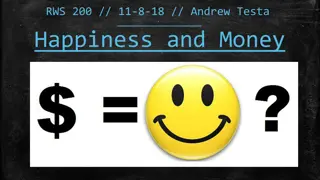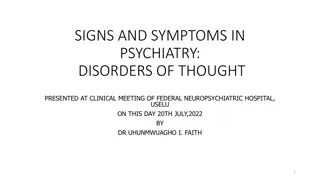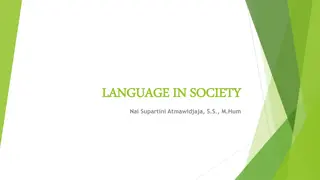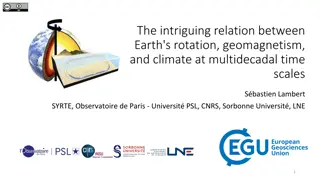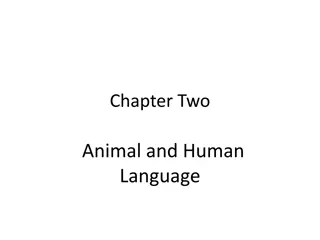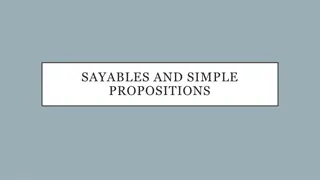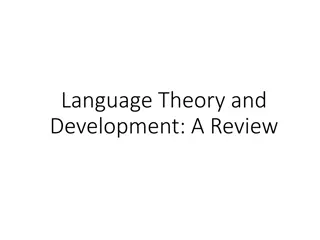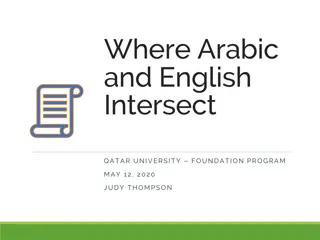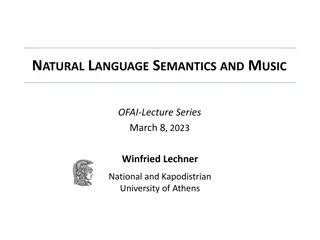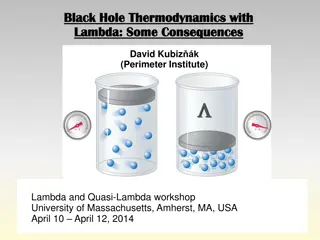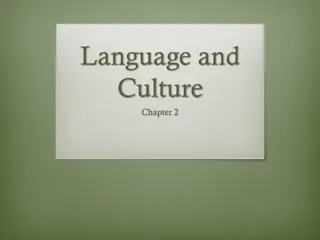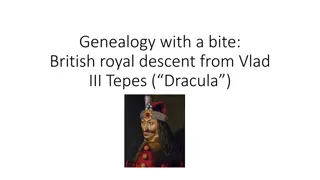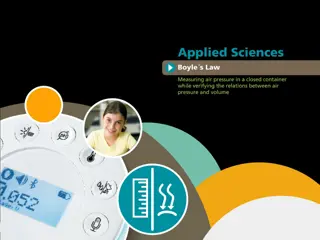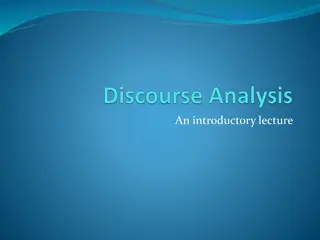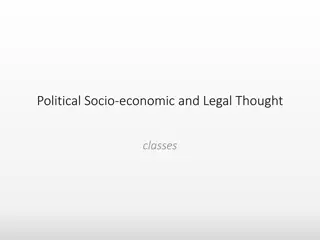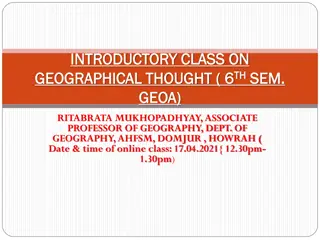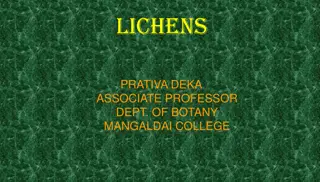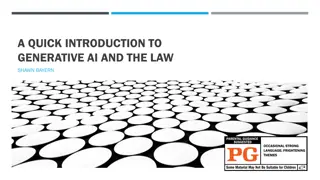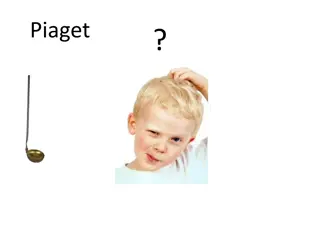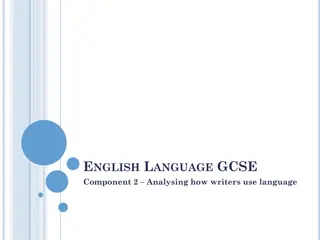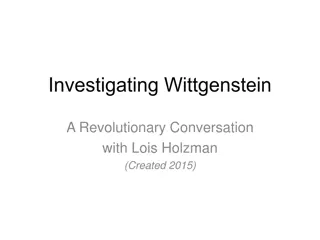The Intriguing Relationship Between Language and Thought
Explore the fascinating connection between language and thought, delving into questions like whether one shapes the other, the impact of political correctness on our thinking, early experiments on language and cognition, word-finding difficulties, and differing perceptions of the world across languages and cultures. Discover insights from Piaget, Sapir & Whorf, and Chomsky, as well as unique perspectives from various linguistic frameworks and examples from diverse languages.
- Language and Thought
- Linguistic Influences
- Cultural Perceptions
- Cognitive Development
- Cross-Cultural Communication
Download Presentation

Please find below an Image/Link to download the presentation.
The content on the website is provided AS IS for your information and personal use only. It may not be sold, licensed, or shared on other websites without obtaining consent from the author. Download presentation by click this link. If you encounter any issues during the download, it is possible that the publisher has removed the file from their server.
E N D
Presentation Transcript
Language and Thought Using ideas from Szamarasz Vera, Bencze Ildik , Fekete Istv n
Language - Thought the same? one makes the other possible? can we think without language? does our language influence our perception of the world? does thinking come before language or the other way round?
Political correctness language use has an effect on the way we think euphemisms in politics pacification = bombing increasing revenue = tax rationalization = lay offs daylight saving time = clocks go forward (ny ri id sz m t s) social movements: sexist/racist etc. language is responsible for sexist/racist etc. thinking chairman chairperson Gypsy Roma (?) blind with visual impairment
Early experiments 1. Behaviorism Watson, 1913: thought = subvocal speech language = thought 2. language thought Smith et al., 1947: curare experiment: muscle relaxant
Language Thought word finding difficulties not saying what you mean learning and creating new words translation between languages animal problem solving
So whats the relationship? Piaget: cognitive development is a prerequisite to language development Sapir & Whorf: language determines cognition Chomsky: language and cognition are independent of each other
Perception of the world Every attested encoding of categories must be within the boundaries of human cognition. Potawatomi (N American Indian) pronouns Korean spatial expressions Tseltal (Mexico) spatial reference Hungarian 3 x 3 locative system Fox (N American Indian) verb modes Hopi (N American Indian) verb tenses Hungarian object agreement
Potawatomi inclusive and exclusive pronouns: we (www.potawatomilang.org)
Korean locatives (Bowerman & Choi 1994, 2001)
Spatial reference (Brown 2001) Egocentric (left, right, in fron of me, behind me) relative Geocentric (hill-wise, sea-wise, etc) absolute Tseltal (Mexico): ajk ol uphill alan downhill
Hungarian locatives Static Goal Source Interior (3D) BAN BA B L Exterior (2D) N RA R L Approximate (dimension neutral) N L HOZ T L
Hopi modes (Boas 1911) No distinction between past, present and future Two aspects: Facts directly experienced by the speaker Facts/ideas known from hearsay, guessing or inferred
Fox tenses (Dahlstrom 1997) he comes/came he is believed to come he s coming after all he s not coming after all pi w pi wen piasah piapah
Hungarian object agreement The verb form signals the specificity of the object Megevett egy alm t. he.ate.something an apple Megette az alm t. he.ate.it the apple
Edward Sapir (1884-1939) US anthropologist Benjamin Whorf (1897-1941) US linguist
The Sapir-Whorf Hypothesis Linguistic determinism Strong version: thought is determined by language Weak version: thought is influenced by language In literature Orwell: 1984 Newspeak Linguistic relativity The diversity of languages is not a diversity of signs and sounds but a diversity of views of the world.
Linguistic relativity: examples 1. colour terms 2. grammatical gender 3. spatial language
Basic colour terms (Berlin & Kay, 1969) Definition 1 morpheme not restricted to a subclass of objects (pl. blonde) do not overlap with other colour terms (pl. turquoise) frequent and in general use Berling & Kay identified 11 basic colour terms: black, white, red, yellow, green, blue, brown, pink, purple, orange, grey.
There are differences between languages in the number of basic colour terms used: 2 (Dani, New Guinea) - 11 Bantu languages: grue (blue + green) Russian: goluboy (light blue), siniy (dark blue) But: There seems to be a universal hierarchy of colour categorisation.
black white red green yellow blue brown purple pink orange grey
Berlin & Kays experiments conclusion: colour perception is not influenced by language Munsell colour chart: saturation, brightness and shade Participants asked to pick the best exemplar The same are chosen independently of language (best grue is the same as best green
More experimental evidence against relativity (pl. Heider & Oliver, 1972; Rosch, 1978) Dani people s performance at distinguishing and recalling colours is as good as English speakers Both Dani and English speakers are better at remembering focal colours (Berlin & Kay s best exemplars)
Experimental evidence for relativity (Kay & Kempson 1984) Participants: English speakers and Tarahumara (Mexico) speakers ( grue language) Task: choose the chip that s different Results: English speakers chose chip with different colour name Tarahumara speakers had no preference
Experimental evidence for relativity (Winnawer et al 2007) Participants: Task: choose the chip of the two at the bottom that s the same as the one on top Distractor task: verbal numerical vs. non-verbal spatial task English speakers and Russian speakers (two blues) Results: Reaction time Russian speakers were faster when the two chips were from different linguistic categories But only with spatial distractor! English speakers RTs were only influenced by the distance between the shades
Left vs. Right Visual Field (Gilbert et al 2006) Conditions: Task: Single different chip in left vs. right visual field Where is the different chip: left or right? Results: Reaction time Faster response for RVF than LVF when the target chip was from another linguistic category But not when it was from the same linguistic category
Is grammatical gender arbitrary? Experiment (Boroditsky & Schmidt, 2003) English speakers assign genders to objects and animals Compared to: object genders in Spanish and German Hypothesis: if grammatical gender is arbitrary, there ll be no agreement Results Animals: significant agreement Objects: chance agreement
Does grammatical gender influence our attitudes towards objects? Experiment (Boroditsky & Schmidt, 2003) Spanish, German and English speakers (language of experiment is English) English speakers assign gender to objects learning: 24 pairs of object + male/female name apple Paul / Paula bench Eric / Erica clock Karl / Karla test: object prompt recall name apple ? bench ? clock ? Results In Spanish and German speakers, better recall of names matching the grammatical gender of the object in their language In English speakers, better recall of names matching the gender assigned to the object
A vilgbank 2018-ban kszlt tanulmnya szerint nagyobb a munkahelyi nemi egyenl tlens g az olyan orsz gokban, amiknek a nyelv ben nyelvtani nemek vannak: http://documents.worldbank.org/curated/en/4 05621528167411253/pdf/WPS8464.pdf (Qubit: https://qubit.hu/2019/03/06/a-nyelvtani- nemek-megkulonboztetese-arthat-a-nok- boldogulasanak )
Exotic genders Dyribal (Australia) bayi: men, kangaroos, bats, snakes, fish, the moon, rainbow, storm, boomerang balan: women, water, fire, duck billed platypus, dog, bird, scorpion, starts balam: edible fruits, plants, honey, cigarettes, wine, cake bela: body part, meat, bee, wind, tree, grass, rock, language, noise Lakoff, Women, Fire and Dangerous Things (1987)
Spatial reference Locating objects in space Levinson: 3 reference frames in languages : 1. 2. 3. Relative Intrinsic Absolute
1. Relative right back front left
3. Absolute North West East South
Where is the fork? Relative: To the left of the spoon. Intrinsic: At the head of the spoon. Absolute: To the East of the spoon.
Reference frames in different languages Absolute Relative Guugu yimithirr (Australia) Arrente (Australia) Tzelt l (Mexik ) Longgu (Solomon Islands) Belhare (Nepal) Bali (Indonesia) English Dutch Japanese Yucatek (Mexik ) Hungarian
Tzeltal No spatial expressions left or right Body parts: left xin right: wa el Absolute reference frame: alan : downhill ~North ajk ol : uphill ~South used indoors and outdoors
Experiments Non-linguistic spatial rotation tasks Dutch (relative) + Tzeltal (absolute) 180 degree rotation: relative vs. absolute reference frames behave differently: relative: switch absolute: no switch
Ecological explanation Choice of reference frame may depend on environment: (city country/open terrain-dense forest) culture: individualism vs. collectivism Li & Gleitman (2002) experiments transferred to a dark room English speakers switched to absolute reference frame The fewer reference points there are, the more difficult it is to use an intrinsic frame




